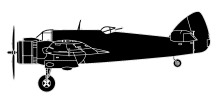
ASN Wikibase Occurrence # 238705
This information is added by users of ASN. Neither ASN nor the Flight Safety Foundation are responsible for the completeness or correctness of this information.
If you feel this information is incomplete or incorrect, you can submit corrected information.
| Date: | Sunday 23 November 1941 |
| Time: | |
| Type: |  Bristol Beaufighter Mk IIF |
| Owner/operator: | 32 MU RAF |
| Registration: | R2393 |
| MSN: | 9800 |
| Fatalities: | Fatalities: 0 / Occupants: 2 |
| Aircraft damage: | Unknown |
| Location: | near RAF Saint Athan, Vale of Glamorgan, Wales -
 United Kingdom United Kingdom
|
| Phase: | Approach |
| Nature: | Military |
| Departure airport: | RAF St Athan. |
| RAF St.Athan |
Beaufighter R2393 (32 Maintenance Unit) crashed on approach RAF St.Athan. 23 November 1941.
Crew:
Pilot Officer R S JORDAN (pilot): injured
Corporal Williams: injured;
Location: Airfield Perimeter.
Squadron: Unassigned.
Details:
No 32 MU was formed at St Athan on 1 July 1939 as a Service Repair Depot, with Aircraft Repair Section, Engine Repair Section, MT Repair Section and General Engineering Section. Which included the fitting of Radar.
R2393 came to St Athan from the Bristol Aeroplane Company at Filton in Bristol. It was one of a batch of 289 aircraft built to MkIIF configuration. The Bristol Beaufighter Mk IIF was similar to the proceeding Mk IF, except for the use of Rolls Royce Merlin XX engines. At the time, Bristol Hercules engines were also used on the Short Stirling bomber, which had priority allocation. To ensure the continuation of Beaufighter production, a trial use of Merlins was used. This resulted in the Mk IIF. As the production of Hercules engines kept up with demand, there was no need to permanently switch, and later versions reverted to the Hercules.
At St Athan R2393 had been fitted with the AI type Radar. (Airborne Interception, Mark IV, or AI Mk. IV for short, was the world's first operational air to air radar. Early Mk. III units appeared in July 1940 on converted Bristol Blenhiem while the definitive Mk. IV reached widespread availability on the Bristol Beaufighter by early 1941. On the Beaufighter, the Mk. IV arguably played a role in ending the Blitz, the Luftwaffe’s night bombing campaign of late 1940 and early 1941). R2393 had just completed tests with the new fitted unit and was on its approach back to St Athan to be signed off and await its posting to the next operational squadron, unfortunately as the pilot turned the Beau’ onto its final approach, it stalled, with its wheels down and locked. On contact they ploughed into the soft November ground, bringing the aircraft to a stop. Nose over, or up! It’s not clear, but the crew were safe and able to see out the war. As for the Beau’, it’s fate remains unknown!
Crew:
P/O Reginald Sydney Jordan 101547 RAF. Pilot. Safe.
Cpl Williams RAFVR. Operator/Obs’. Injured.
Wreckage:
Removed completely. Status not known.
Additional information:
The lack of details post-crash and fate of aircraft and equipment would have been deemed ‘Secret’ due to the nature of the equipment on board also, the Maintenance Unit responsible would have been Secret as well at the time.
Sources:
AIR81/10446
www.britishaviation-ptp.com/b/bristol_type156.html
www.baesystems.com
Local Knowledge
Revision history:
| Date/time | Contributor | Updates |
|---|---|---|
| 27-Jul-2020 10:41 | Nepa | Added [Operator] |
| 21-May-2021 17:52 | Anon. | Updated [Location, Operator] |
| 10-Nov-2021 08:33 | Davies 62 | Updated [Cn, Departure airport, Source, Damage, Narrative] |
Corrections or additions? ... Edit this accident description
The Aviation Safety Network is an exclusive service provided by:


 ©2024 Flight Safety Foundation
©2024 Flight Safety Foundation